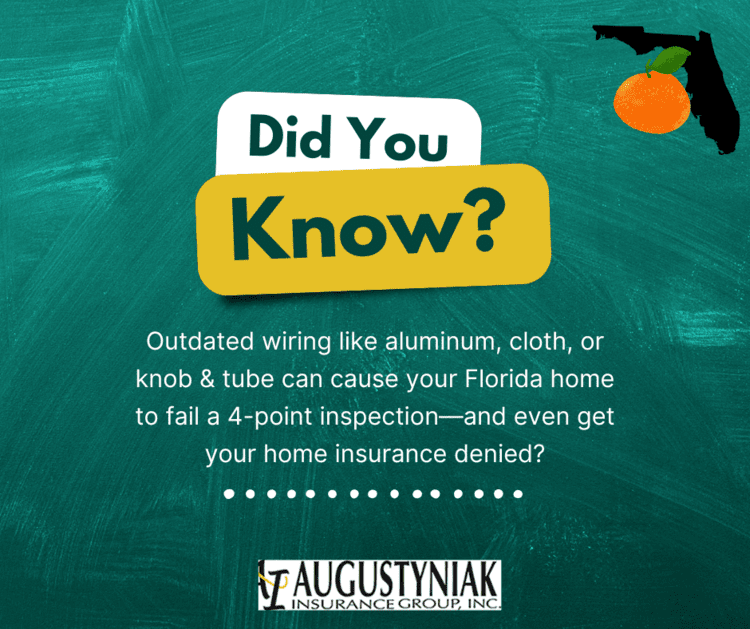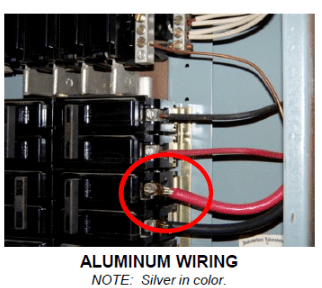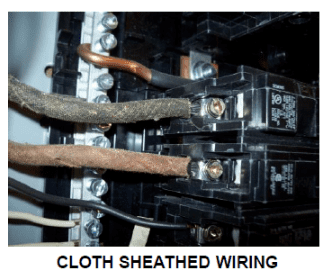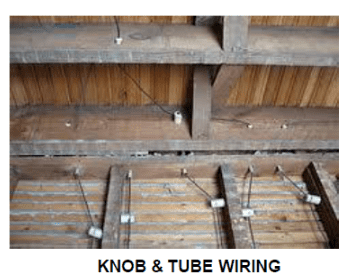
Are Aluminum, Cloth, and Knob & Tube Wiring a Florida Home Insurance Dealbreaker?
Yes, absolutely. The wiring within a home's walls is a critical factor for securing homeowners' insurance in Florida. Older, outdated wiring systems like aluminum, cloth-insulated, and knob-and-tube are a significant concern for insurance companies and often cause a home to fail a 4-point inspection.
These wiring types pose a serious fire risk due to their age and design flaws. Due to this heightened risk, many insurers will either deny to offer a policy, cancel a policy, or charge significantly higher premiums.
In this article, you will learn why these three specific wiring types are a major issue and what you can do to address them.
Can you get homeowners' insurance in Florida with aluminum wiring?
Obtaining homeowners' insurance for a home with active single-strand aluminum wiring can be extremely challenging and often requires specialized, professional remediation. Most insurance companies will not offer a policy due to the significant fire risk associated with this type of wiring.
However, some carriers, including Citizens Property Insurance and Tower Hill, may consider a policy if the single-strand aluminum wiring has been professionally remediated using CPSC-approved methods.
Single-strand vs. multi-strand aluminum wiring - An important distinction for insurance
- Single-Strand Aluminum Wiring (1960s–1970s): Typically used on standard branch circuits (outlets, lights, switches) and considered a fire hazard. It's uninsurable without remediation.
- Multi-Strand Aluminum Wiring (Still Code-Compliant): Common and even used today as the current building code for 220-volt circuits serving large appliances like dryers, ovens/ranges, and air conditioners. This type is acceptable to insurers and does not require remediation or replacement.
What is single-strand aluminum wiring?
- Period of Use: Used from the mid-1960s to the late 1970s.
- Reason: It was a cheaper alternative to copper during a period of high copper prices.
- Appearance: Wires are a dull, silvery color and are often marked with “AL” or “ALUMINUM” on the insulation.

Aluminum Wiring Can Get Your Home Insurance Cancelled or Denied
The Consumer Product Safety Commission (CPSC) has found that homes with single-stranded aluminum wiring are 55 times more likely to have a fire hazard than homes with copper wiring. The primary issues are:
- High Thermal Expansion: Aluminum expands and contracts much more than copper when heated and cooled. This can cause loose connections at outlets, switches, and other terminals. Loose connections create resistance, which leads to dangerous overheating and a fire hazard.
- Oxidation: When exposed to air, aluminum oxidizes, forming a non-conductive layer on its surface. This process increases resistance at connections, leading to more heat and a greater risk of fire.
- "Cold Creep": Aluminum is a softer, more malleable metal than copper. Over time, the pressure from screw terminals can cause the wire to "creep" or deform, loosening the connection and increasing the fire risk.
Warning Signs of Aluminum Wiring Problems:
- Warm switch or outlet faceplates.
- A strange or burning plastic smell near a switch or outlet.
- Flickering lights not caused by appliances or external factors.
The Cost to Fix Aluminum Wiring (single strand)
Do not attempt to repair this yourself. A licensed electrician must do all work.
There are two primary ways to address single-strand aluminum wiring:
- Complete Rewiring: The most permanent and secure solution is to replace all aluminum wiring with copper. This is also the most expensive option, with costs typically ranging from $12,000 to $25,000.
- Retrofitting with Approved Connectors: Many insurers will accept this less expensive alternative. The CPSC recommends two methods:
- COPALUM: A cold-welding process that creates a permanent connection between aluminum and copper. A certified electrician must do this.
- AlumiConn: A specialized connector that safely joins aluminum and copper wires securely.
The estimated cost for a professional retrofit with these connectors is $1,500 to $5,000, depending on the number of connections.
Can you get Home insurance in Florida with cloth wiring?
It is very difficult to insure a home with active cloth wiring.
While some older homes with cloth wiring may be insurable if the wiring is in exceptional condition, most insurance companies, including Citizens Property Insurance, consider it a significant fire hazard. A complete electrical replacement is often required to secure a policy.
What is Cloth Wiring?
- Period of Use: Common in homes built before the 1960s.
- Appearance: Wires are insulated with a fabric-like material, sometimes with a layer of tar or paper underneath.

Close-up of Cloth Wiring entering the Breaker box
Why is Cloth Wiring a Major Risk?
- Deteriorating Insulation: The cloth and rubber insulation dries out and becomes brittle over time, especially in Florida's heat and humidity. This leads to cracking and flaking, exposing the live wires underneath, which can cause electrical shorts and fires.
- Increased Fire Hazard: Exposed wires and insulation that can easily catch fire pose a severe risk. The material itself is often flammable, and the risk is compounded by the fact that it was not designed for the high electrical demands of modern homes.
- Lack of Grounding: Like knob and tube, older cloth wiring systems typically lack a ground wire. This is a critical safety feature that provides a path for excess electricity in the event of a fault, protecting people from electrical shocks and preventing damage to appliances.
The Cost to Fix Cloth wiring
Do not attempt to repair this yourself. A licensed electrician is required for all work.
- Complete Rewiring: A full replacement of the electrical system is the most secure and often required solution.
- Estimated Cost: The cost for a complete home rewiring in Florida typically ranges from $12,000 to $25,000 or more, depending on the size of the home and the accessibility of the wiring. While it's a significant expense, it not only improves safety but can also make a home eligible for more insurance options and potentially lower rates.
Can you get home insurance in Florida with Knob and Tube Wiring?
The short answer is: Almost never, if it is still active.
Due to significant safety risks, most Florida insurance companies—including state-backed Citizens Property Insurance—will refuse to issue or renew a policy on a home with active knob and tube wiring. A complete electrical replacement is generally the only viable solution to secure coverage.
What is Knob and Tube Wiring?
- Period of Use: This was the original method of electrical wiring in U.S. homes, common from the 1880s to the 1930s.
- Appearance: It consists of porcelain "knobs" that support single insulated wires along rafters and joists. Porcelain "tubes" protect the wires where they pass through wood framing.

Why Knob and Tube WiringCan Get Your Home Insurance Cancelled
- No Grounding: This is the most critical issue. Modern appliances and electronics are designed to operate with a grounded electrical system. Without a ground wire, a fault in an appliance can lead to a severe electrical shock or damage to the device.
- Degrading Insulation: The original rubber and cloth insulation around the wires becomes brittle and crumbles over time, especially in hot, dry areas like attics. This leaves live wires exposed, creating an extreme fire hazard.
- Overloaded Circuits: Knob and tube was designed for the minimal electrical loads of the early 20th century. Today's high-demand homes with numerous appliances, air conditioners, and electronics can easily overload these outdated circuits, causing overheating and increasing the risk of fire.
- Improper Modifications: Over the decades, many homeowners or unlicensed handymen have made unsafe modifications, such as covering the wiring with insulation, which can cause the wires to overheat, or splicing new wires onto old, brittle ones.
The Cost to Fix Knob and Tube Wiring
Do not attempt to repair this yourself. A licensed electrician must perform all work.
- Complete Rewiring: The only permanent solution is to replace all knob and tube wiring completely.
- Estimated Cost: The cost typically ranges from $12,000 to $25,000, but this can vary significantly based on the size, age, and accessibility of your home.
What Are Homes Wired With Today?
Modern homes are wired with copper wiring insulated in plastic (NM-B cable, often called “Romex”). Unlike older systems, today’s wiring includes a grounding conductor, which is required by code and adds an extra layer of safety. This type of wiring is designed to handle modern electrical loads, works with updated breaker panels, and is fully acceptable to insurance companies.

⚡ Florida Home Insurance Wiring Comparison Table
| Wiring Type | Years Commonly Used | Key Problems | Insurance Stance (Florida) | Typical Fix Cost | What Homes Are Wired With Now |
|---|---|---|---|---|---|
| Knob & Tube | 1880s–1930s | No grounding, exposed wires, can’t handle modern loads | Almost always uninsurable | $12,000–$25,000 (rewire) | – |
| Cloth Wiring | Pre-1960s | Insulation crumbles, fire hazard, often no grounding | Rarely accepted (Citizens only in excellent condition) | $10,000–$18,000 (rewire) | – |
| Aluminum Wiring | 1960s–1970s | Expands/contracts, loose connections, corrosion | Single Stranded is Not insurable unless remediated (Citizens/Tower Hill allows with connectors) | $1,500–$5,000 (retrofit) or $12,000–$20,000 (rewire) | – |
| Modern Copper Wiring (Romex) | 1970s–Today | Safe, grounded, plastic insulation (PVC or THHN) | Fully acceptable with insurers | – | ✅ Standard for today’s homes |
💡 Pro-Tip From Our Agents: When touring an older Florida home, always look at the electrical panel. Brands like Zinsco and Federal Pacific Electric (FPE) are often found alongside outdated wiring and are a major red flag for insurers.
Learn more about electrical panels that can get your home insurance denied in Florida.
What To Do If Your Florida Home Has Aluminum, Cloth, or Knob & Tube Wiring
✅ Talk to Your Insurance Agent Early
Before your policy is up for renewal or before moving to a new company, speak with your insurance agent. They can explain which Florida insurers may accept your situation (with remediation or rewiring) and what documentation is needed.
✅Get Multiple Quotes from Licensed and Insured Electrical Contractors
Reach out to several qualified electrical contractors and request written quotes for inspection and repair. This helps you compare costs, understand the scope of work, and ensure the contractor is licensed and insured
✅ Schedule an Updated 4-Point Inspection After Repairs
If your home initially failed a 4-point inspection due to aluminum, cloth, or knob & tube wiring, you’ll need a follow-up inspection after the repairs are complete. Have a licensed inspector return and issue an updated 4-point inspection report that shows the wiring has been replaced or remediated. Insurance companies require this documentation before they will approve or renew coverage.
✅ Plan for Repair or Replacement
While rewiring can be a significant investment, it dramatically reduces fire risks and makes your home more insurable with a wider range of carriers. In some cases, remediation (such as COPALUM or AlumiConn connectors for aluminum wiring) may be an acceptable solution.
✅ Don’t Wait Until You Are Cancelled
If you wait until your insurer denies coverage or cancels your policy, you’ll have fewer options and higher costs. Being proactive gives you time to make repairs and shop the market.
Related Reading
- Electrical Panels That Can Get Your Home Insurance Denied in Florida
- What is a 4-point Inspection in Florida?
- Top 25 Largest Home Insurance Companies in Florida
Worried Your Wiring May Get Your Insurance Cancelled or Denied?
Contact Augustyniak Insurance for advice or to connect with a licensed inspector who understands Florida 4-point inspections.
We’ll help make the process easier—and safer.
⭐Augustyniak Insurance is proud to be Rated 4.9 stars with 2,060+ reviews in Florida
Frequently Asked Questions about Wiring & Florida Home Insurance
❓ Is aluminum wiring a dealbreaker for home insurance in Florida?
Yes—if your home has single-strand aluminum wiring, most insurers will not provide coverage unless it has been professionally remediated with CPSC-approved methods. However, multi-strand aluminum wiring used on 220-volt circuits for appliances like dryers and ovens. It is still code-compliant and generally acceptable to insurers.
❓ What’s the difference between single-strand and multi-strand aluminum wiring?
- Single-strand aluminum was used in the 1960s–70s on outlets, lights, and switches. It expands, contracts, and corrodes, making it a major fire hazard.
- Multi-strand aluminum is still used today for large appliances (220-volt circuits). It is code-approved, safe, and does not require remediation or replacement.
❓ Can I get home insurance with cloth wiring in Florida?
It is very difficult. Cloth wiring is considered a fire hazard due to its deteriorating insulation and lack of grounding. Most insurers, including Citizens, require a complete rewiring before offering coverage.
❓ Is knob and tube wiring insurable in Florida?
Almost never. Knob and tube wiring lacks grounding, cannot handle modern electrical loads, and is prone to fire hazards. Insurers will nearly always require a complete rewiring before approving coverage.
❓ What type of wiring do modern homes use?
Today’s homes are wired with copper wiring in plastic insulation (Romex/NM-B). It includes a grounding conductor, can handle modern loads, and is fully acceptable to Florida insurers.
❓ What should I do if my Florida home has outdated wiring?
Work with your insurance agent early, get licensed electricians to provide quotes, and schedule a 4-point reinspection after repairs. Rewiring or approved remediation can make your home safer and more insurable.

Discussion
There are no comments yet.